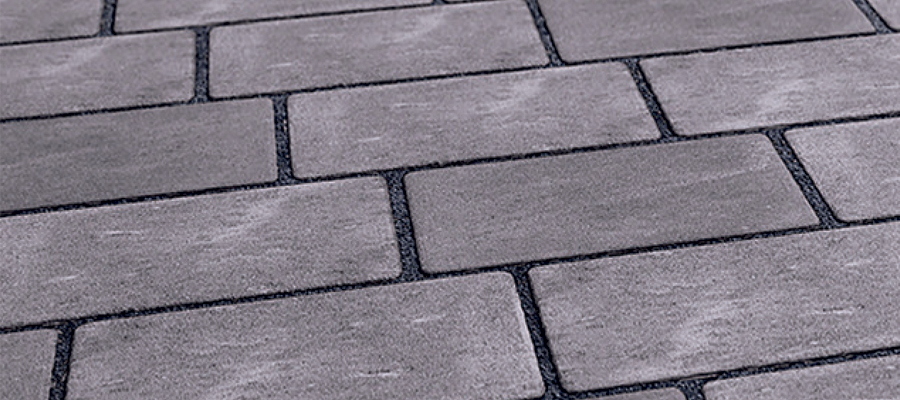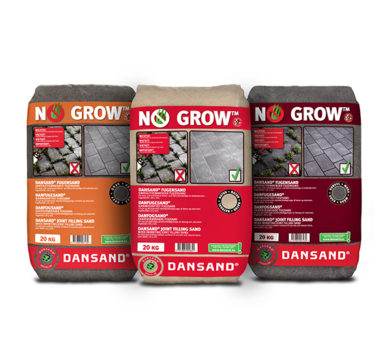
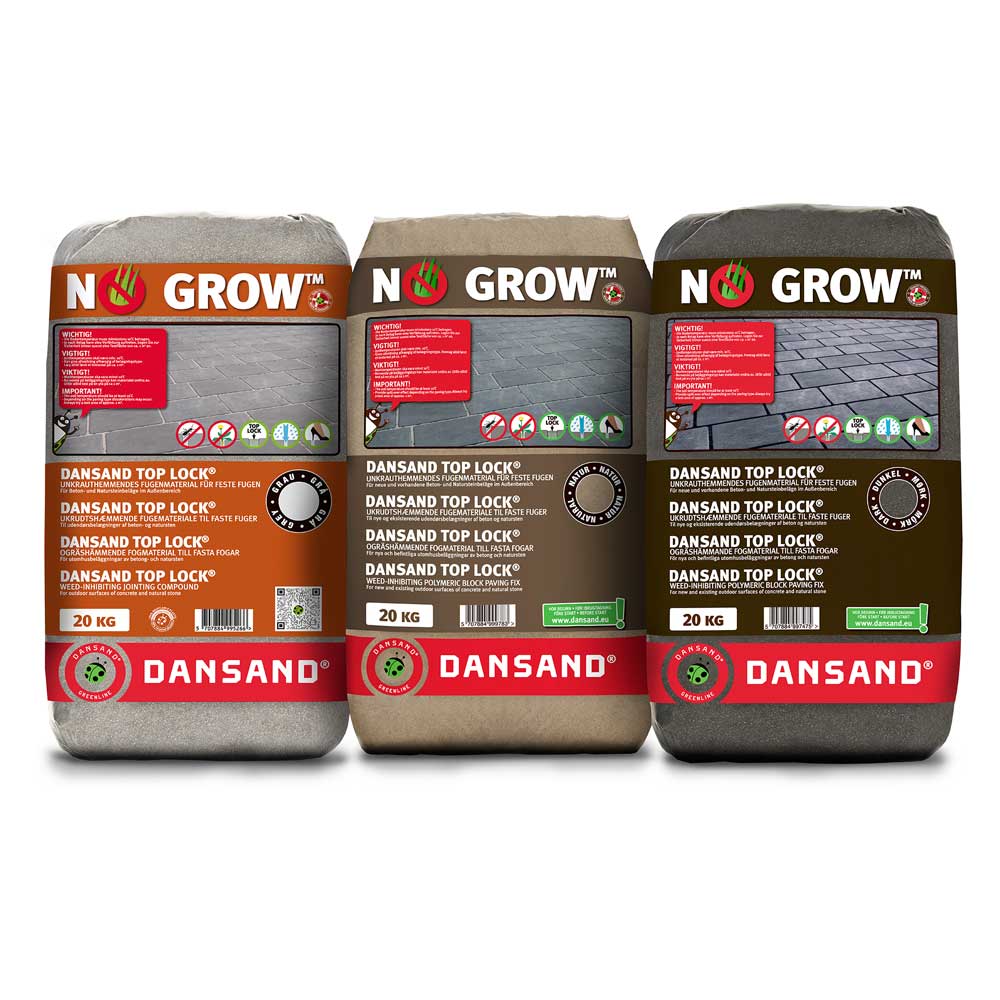
Polymeric block paving fix with weed-retarding properties
Brand name in the UK: DANSAND® Firm Fix


Additional information
| Responsible: | |
|---|---|
| E-mail: | |
| Producer: | |
| Product designation: | Washed, kiln-dried and sorted silica sand, binding agents and cement |
| Tel: | |
| Item number: | |
| Variant: | Anthracite, Nature |
| Variants: | Anthracite – 600411, Nature – 600612 |
Description
DANSAND TOP LOCK® is a durable polymeric block paving fix which is easy to use. The polymeric block paving fix is based on fine, oven-dried, round-edged silica sand, making it easy to distribute the material in joints.
TOP LOCK® polymeric block paving fix has an optimum grain curve making the material easy to compact into joints, giving you stable, durable and flexible paving joints. During rainfall, the joints become elastic and will harden again in dry conditions, forming a sturdy barrier against weed seeds and insects.
TOP LOCK® polymeric block paving fix is suitable for use in patios, driveways and paths. TOP LOCK® polymeric block paving fix forms stable and water-permeable joints with a long life. The hardened joint becomes strong and elastic, allowing it to withstand repeated sweeping, frost and minor substrate movements. The solution is easy to maintain and can be used for new paving joints and for repointing of existing surfaces.
Use our coverage calculator to estimate the amount you need for your project. As a guideline, expect to use 20 kg for 5-10 square meters.
Benefits of DANSAND TOP LOCK®
- Washed, oven-dried silica sand with binding agents
- Firm, flexible paving joints
- Natural weed-retardant effect
- Water-permeable
- Easy to sweep into joints
- For joints with a width of 3-10 mm
- Effective at a joint height of minimum 40 mm
Specification
Declaration
Silica sand, cement and organic binding agents. Available in neutral or anthracite colours. Ready-mixed and can be used directly from the bag.
Packaging
Frost-proof foil. Plastic bags made of PP material.
Storage
The bags can be stored outdoors during the summer. Store in a dry place in winter. We recommend a covered storage location, as the plastic foil cannot tolerate heavy rain. Open bags must be closed again.
Safety
Safety data sheets can be requested here.
Delivery
20 kg in frost-resistant foil bag.
Environmental information and disposal
The joint material must not be classified as hazardous according to the Ministry of the Environment’s rules for classification and labeling. Residues are handed in at the recycling station. The joint material must not be poured into the sewer. The content of soluble chromium IV is less than 2 mg/kg of cement dry weight. Reductive agent is active 18 months after packaging date.
The authorities’ requirements for the establishment, maintenance and grouting of fortified areas may vary nationally and locally. Therefore, familiarize yourself with the applicable national and / or local regulations before starting the joint work.
| Grain size | 0-1.5 mm |
|---|
Manual
Application
For joints between new or existing paving stones (concrete or natural stone). Ideal for patios, garden paths and driveways with limited traffic. Only for use on unbound substrates. Only for outdoor use. Suited for private use.
Estimated consumption: Approx. 2,0 kg/m2 at 3 mm joints. Our coverage calculator can help you calculate the amount you need.
Minimum joint depth is 40 mm. Joints can be from 3-10 mm in width.
Here’s how you do it
Paving stones are laid on a sustainable gravel and sand layer in accordance with current standards for paving work. The joint material is water-permeable like ordinary joint sand. Therefore, the base layer must also be water-permeable.
Repointing
DANSAND® polymeric block paving fix is not a remedy for weeds. To prevent existing weeds from growing, all weeds – including weed roots – must be removed before grouting. Clean the joint to a depth corresponding to the entire height of the stone. This is done using a joint cleaner. You can also use a high-pressure cleaner, but be careful not to damage the coating or the sublayer. Top up the joint.
Maintenance
To avoid weeds and displacements in the coating, the joint must always be filled to the full height of the joint edge and be completely free of soil and other organic material. The coating is cleaned with a stiff broom and the joints are refilled as needed. Moss and algae can be removed by suitable means. Extreme weather conditions can cause white blooms in the joints and on the edges of the paving stones. However, they are usually washed off at the next rain shower. The salt deposits can also be removed by regular cleaning of the stones.
Comments
- If you use the filling material for coloured, porous pavings, it may settle in small depressions in the stones, leading to discolouring. This can often be removed with a brush and some soap – see how in our cleaning guidelines.
- Always prepare a test area of at least 0.5 m2 before beginning
- The filling material will not withstand constant erosion by water
| Step 1 | |
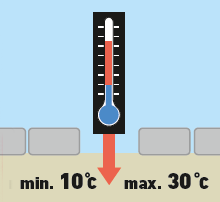 | During joint filling and during the first days of hardening, the air and soil temperature must be at least 10 ° C. |
| Step 2 | |
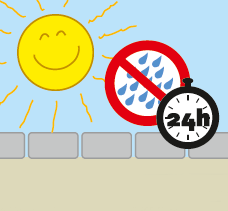 | Both the weather and the substrate must be dry for the joint to harden completely. The joint does not withstand rain (except fine drizzle and dew) for the first 24 hours. |
| Step 3 | |
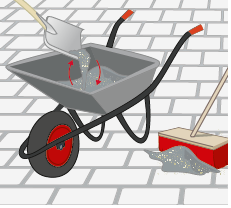 | Check the weather forecast before beginning to work. Mix the contents in a mason jar or a wheelbarrow so that the binders are mixed with the silica sand. Never mix the contents of more than two bags at a time. |
| Step 4 | |
 | Sweep the filling material into the joints using a soft broom. Sweep lengthwise and diagonally on the joints until they are completely filled. |
| Step 5 | |
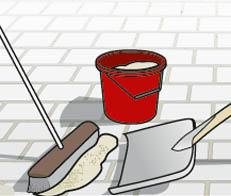 | Sweep the surface completely free of excess material. Use a soft broom. |
| Step 6 | |
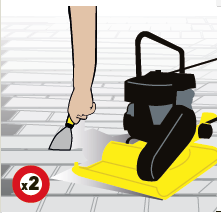 | Compact the joints using a vibrating plate - do this at least twice. Use a protective rubber mat to protect the paving. Check that the joint is fully compacted - use a spatula. You should only be able to press the spatula one or two mm into the joint. |
| Step 7 | |
 | Refill if needed and sweep the paving completely clean using a soft brush. |
| Step 8 | |
 | Moisten the joints with a garden hose with the nozzle set to fine water mist. Watering cans are not suitable. IMPORTANT! The process should be repeated after about 5 minutes. Moisten no more than max. 20 m 2 at a time. The wetting is checked by scratching up some grout. Make sure that the joint is moistened int its entire height corresponding to the stone height. Begin the process from the lowest end of the drop. Using a pointed object, check that the joints are moistened to their full depth. Be careful when watering. Do not overwater. The coating can be walked on after about 2 days and can withstand light traffic after about 3 days (in dry weather and about 20° C) |
Vejledning og gode råd

Beregn, hvor meget fugemateriale, du skal bruge. Uanset om du skal fuge en ny belægning, eller blot skal fylde de eksisterende fuger op, er der hjælp at hente her på siden.
Her har vi samlet vores bedste råd til, hvordan du kan opnå de bedste resultater med vores effektive fugeprodukter. Hvilket fugemateriale skal jeg vælge?








